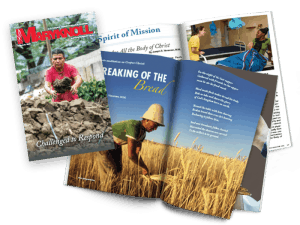By Hugh Menton
Sunday, July 10, 2022
Deuteronomy 30:10-14; Colossians 1:15-20; Luke 10:25-37
A Maryknoll affiliate reflects on the Good Samaritan parable in light of visiting Maryknoll lay missioners serving in El Salvador.
The passage from Luke’s Gospel has always communicated to me the essential message of our Christian faith — love God and love my neighbor.
The story of the Good Samaritan ends quite simply, “Go and do likewise.” But what is doing “likewise,” particularly if I find myself living more like the Jewish scholar, the priest or the Levite than the Samaritan who shows mercy traveling that notorious road to Jericho?
For me as a Maryknoll affiliate, I encounter the “robber’s victim” through connections with the Maryknoll Lay Missioners, Maryknoll Sisters and Maryknoll Fathers and Brothers in their communities and countries of service.
My brief immersion trip with the Maryknoll Lay Missioners in El Salvador – seeing Ann Greig’s work with the women to provide affordable soy milk resources in a poor San Salvador neighborhood where the infant/child mortality rate is huge; Larry Parr’s community/study center work with youth in a gang-controlled area; Peg Vámosy’s work with organic farmers; or Rick Dixon’s work with children and families using a wheelbarrow library to build relationship, community and literacy – took me from the “opposite side” of the road to doing “likewise.”
I took away the lay missioners’ and Maryknoll approach of being present to the communities they were joining, where they offer their gifts to the people, as the Samaritan bandaged, transported and housed the robbers’ victim.
I brought this approach back to my life in Southern California. In order to do “likewise,” I found my presence was needed. A missioner’s work flows from the needs of the community one serves and it is shaped by that community. Like the robbers’ victim’s needs which were visible to the Samaritan, missioners are guided by observation and interaction. I found the same approaches in “doing likewise” with the homeless and poor of the local U.S. communities.
There is one aspect of relationship that does not unfold in the story of the Good Samaritan. A relationship between the Samaritan and the robbers’ victim is missing from the story. It is only implied with the Samaritan’s suggestion of a return and left up to our imaginations in our own journeys. In Maryknoll missioners’ lives, in the communities where they serve, it is clear that the relationships that develop between missioners and those served is that of neighbors. Both the missioners and the communities know the answer to the scholar’s question, “And who is my neighbor?”
The missioners’ examples lead me to the related wisdom from today’s Hebrew text, “…this command that I enjoin on you today is not too … remote for you … Nor is it across the sea.” Our neighbors, suffering like the robbers’ victim, are right before us in our sight, calling for mercy and relationship, as are we.
Hugh Menton is the Maryknoll Affiliate regional coordinator for California and Hawaii in the Greater Los Angeles Maryknoll Affiliate Chapter.
To read other Scripture reflections published by the Maryknoll Office for Global Concerns, click here.
Featured image: Maryknoll Lay Missioner Ann Greig (right) fills containers with soy milk produced by a cooperative for families in need in San Salvador, El Salvador. (Meinrad Scherer-Emunds/El Salvador)

